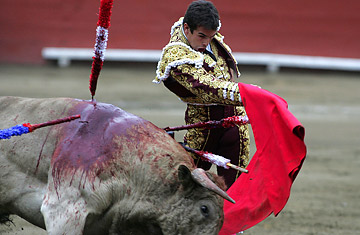
Spanish bullfighter Jose Mari Manzanares performs a pass to his bull during a corrida at the "Senor de los Milagros" festival at Lima's Acho bullfighting stadium.
Anyone needing to find Maria Victoria Jimenez on a Sunday afternoon in November knew where to look: It was the month for bullfights in Lima, and Jimenez says she hasn't missed a bout in Peru's capital since her father started taking her along in the 1940s.
Not bothered by the dusty cement bleachers or the blazing afternoon sun at Acho, the oldest plaza of its kind in the Americas with its current structure dating back to 1766. The 65-year old grandmother with a wineskin dangling around her neck watched through binoculars as the first bull rushed from the stalls as the clock struck 3.30 p.m. "I have been coming every year since I was five years old," she said. "I was hooked right away and have never missed a season."
She was among a small group who remained faithful to the ritual, even during the early 1990s when attendance was at an all-time low, as the government neglected the stadium and its sport, eventually allowing a private operator take charge. But things have changed dramatically in recent years, with Peru's booming economy having restored the bullfighting arena as the place to be seen on a leisurely November Sunday afternoon. Acho is full to capacity, now with around 10,000 people watching the bullfights, as well indulging in the festivities before and after that rival the best tailgating parties in United States. And, of course, the numbers were boosted last Sunday as delegates attending the annual Asia-Pacific Economic Cooperation forum took time off from plotting the rescue of the world economy to watch the matadors at work.
Among the crowd-pleasers, this year, was Spain's David Fandila, known simply as "El Fandi," who mixes technical prowess with athletic ability. His moves get people on their feet and almost always end with him receiving a severed ear or two at the end of each match. The multi-talented Fandi arrived for this year's bullfighting season fresh off completing the New York marathon.
This season also included Peruvian newcomer Alfonso Simpson, who is studying to be a doctor. He got his first shot at fighting in Lima on Nov. 9, winning over the crowd by dusting himself off and finishing the job after being flipped twice by his 1,400-pound opponent. Simpson broke his collarbone, forcing Fandi to take his second bull of the afternoon. The crowd roared.
One beneficiary of Lima's resurgent interest in bullfighting is Gladys Vilca, operator of an open-air food stall in the passageway that circles the ring for the past 14 seasons. Vilca offers cow heart kebabs, known locally as anticuchos, and picarones, a kind of pumpkin funnel cake. The line in front of her fryers remains long after the matadors have left and the aficionados linger to discuss the events of the day.
"There are more people coming each year and they are learning," she said, between hawking flimsy plastic plates loaded down with juicy kebabs, potato slices and sections of large-kernel corn. "These bullfights are not for everyone, but they are part of us."
Jimenez is also pleased by the larger crowds, although she expressed nostalgia for earlier times when the crowd was more knowledgeable. "Many people now come just to be seen," she complained. "I think we are losing part of the art of the bullfight, because people are not interested anymore in what happens between the bull and the matador."
Acho's four or five fights each season are but a small fraction of the estimated 500 staged annually throughout Peru. Many of the smaller plazas are much more hands-on, with spectators jumping the barricades to get a brief shot at playing matador. Spectator involvement may be one reason why these smaller rural arenas were spared the downturn suffered by Acho. Another reason is the price. Staging the bullfights at Acho costs hundreds of thousands of dollars, which is why the price of seats even in the less expensive sunny side of the arena is $50. By contrast, a ticket to a town bullfight in Ayacucho, in the central highlands, runs around $5.
Not everyone is thrilled by the renewed enthusiasm for Sunday's entertainment at Acho. A dozen protesters carried anti-bullfighting signs in front of the arena on the second Sunday of the short season. They were surrounded and outnumbered by mounted police officers by more than two-to-one.
William Soberon, first protested outside of Acho more than a decade ago, blamed the news media, wealth Peruvians and the Catholic Church for perpetuating the annual ritual. "I wouldn't care if I were the only one here, someone has to stand up and say enough," he said. "This is not a sport or art. It is cruelty."
